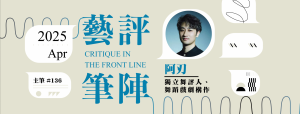Theatre being the dynamic form it is, there is always room for many forms of expression -- which makes it a fertile field for arts for the disabled. For the actors and the audience alike, theatre has all ways been a powerful educational and therapeutic tool. Untie the Boat from the Ugly Wharf is performed by a group of hearing-impaired performers from the Theatre of the Silence with assistance from the Arts with the Disabled Association Hong Kong. Directed and written by Tony Strachan, artistic director of the Australian Theatre of the Deaf, the story follows the adventures of a distressed Hong Kong woman who sets out on a long sea voyage with her baby son in search of a distant aunt in Singapore.
Armed with a sampan, a Tin Hau (Chinese Goddess of the Sea) stature, a compass and sheer faith, the woman unties her boat and embarks on a long tortuous journey along the South China Sea and coastal towns in hope of finding a better life. In the process, she endured the onslaught of hunger, theft, mirages, storms, ferocious beasts, unfriendly strangers and pirates. Miraculously, she reached Singapore where her aunt showed her a dignified life and trained her into a Chinese doctor. Years later, she returned to Hong Kong transformed, to be interviewed for her autobiography and got reunited with her son whom she had lost in the sea voyage.
Laden with overt political overtones, the plot has been developed by the director's views of Hong Kong's recent "uneasy attitude towards the Mainland". The synopsis explains that the protagonist's situation reflects Hong Kong's current dilemma -- that "Hong Kong is like her small boat tied to a very big wharf".
What mystery that the plot lacked was made up by the wonderful choreographed movements and gestures that the acting team displayed. The six actors were lithe, communicative and captivating. Actors who are hard of hearing perform differently from others -- they are more alive. They display a sense of full physical expression and full emotional availability deriving from physical action and physical presence. In grand gestural forms, they became crashing waves, turbulent winds, clapping thunder, ferocious beasts and graceful schools of fish. The gestural form, like sign language, has syntax based on placement, motion and expression. If the spoken languages are sung, then sign languages are danced. It is in this spirit that a good deaf theatre calls for strongly visual and poetic playwrights.
Of particular visual interest was the creative use of wiring to create most of the props needed in the set -- including the sampan, a variety of hat pieces that represent different characters and cultures, a birdcage and a giant tortoise. Music and lighting were on the dark side, creating an overpowering sense of gloom even over the scarce moments of comic relief.
Following the protagonist's long journey that lasted almost two hours, the audience was given a run-through of the route and events that her ancestors went through emigrating from Mainland China into different cities of Southeast Asia some generations ago. It was the director's intention to incorporate the stories of Chinese families' endurance portrayed in books like Falling Leaves and Life and Death in Shanghai - but it turned out to be an overdose in subject matter and sentimentality. A lighter and shorter treatment of plot would be more suited to highlight the special talents of the actors.
All in all, the production is a commendable effort on the part of the acting, organisational and production teams who are obviously searching for new forms in which the deaf and the hearing communities can communicate easily and unselfconsciously.
本網站內一切內容之版權均屬國際演藝評論家協會(香港分會)及原作者所有,未經本會及/或原作者書面同意,不得轉載。









